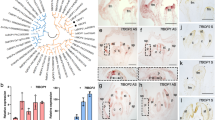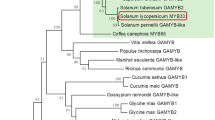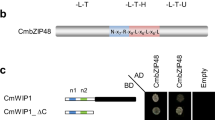Abstract
The Arabidopsis homeotic gene AGAMOUS (AG) is necessary for the specification of reproductive organs (stamens and carpels) during the early steps of flower development1,2,3. AG encodes a transcription factor of the MADS-box family that is expressed in stamen and carpel primordia. At later stages of development, AG is expressed in distinct regions of the reproductive organs2,3,4,5. This suggests that AG might function during the maturation of stamens and carpels, as well as in their early development. However, the developmental processes that AG might control during organogenesis and the genes that are regulated by this factor are largely unknown. Here we show that microsporogenesis, the process leading to pollen formation, is induced by AG through activation of the SPOROCYTELESS gene (SPL, also known as NOZZLE,NZZ), a regulator of sporogenesis6,7. Furthermore, we demonstrate that SPL can induce microsporogenesis in the absence of AG function, suggesting that AG controls a specific process during organogenesis by activating another regulator that performs a subset of its functions.
This is a preview of subscription content, access via your institution
Access options
Subscribe to this journal
Receive 51 print issues and online access
$199.00 per year
only $3.90 per issue
Buy this article
- Purchase on Springer Link
- Instant access to full article PDF
Prices may be subject to local taxes which are calculated during checkout




Similar content being viewed by others
References
Bowman, J. L., Smyth, D. R. & Meyerowitz, E. M. Genes directing flower development in Arabidopsis. Plant Cell 1, 37–52 (1989)
Yanofsky, M. F. et al. The protein encoded by the Arabidopsis homeotic gene agamous resembles transcription factors. Nature 346, 35–39 (1990)
Bowman, J. L., Drews, G. N. & Meyerowitz, E. M. Expression of the Arabidopsis floral homeotic gene AGAMOUS is restricted to specific cell types late in flower development. Plant Cell 3, 749–758 (1991)
Drews, G. N., Bowman, J. L. & Meyerowitz, E. M. Negative regulation of the Arabidopsis homeotic gene AGAMOUS by the APETALA2 product. Cell 65, 991–1002 (1991)
Reiser, L. et al. The BELL1 gene encodes a homeodomain protein involved in pattern formation in the Arabidopsis ovule primordium. Cell 83, 735–742 (1995)
Schiefthaler, U. et al. Molecular analysis of NOZZLE, a gene involved in pattern formation and early sporogenesis during sex organ development in Arabidopsis thaliana. Proc. Natl Acad. Sci. USA 96, 11664–11669 (1999)
Yang, W. C., Ye, D., Xu, J. & Sundaresan, V. The SPOROCYTELESS gene of Arabidopsis is required for initiation of sporogenesis and encodes a novel nuclear protein. Genes Dev. 13, 2108–2117 (1999)
Mizukami, Y. & Ma, H. Ectopic expression of the floral homeotic gene AGAMOUS in transgenic Arabidopsis plants alters floral organ identity. Cell 71, 119–131 (1992)
Honma, T. & Goto, K. Complexes of MADS-box proteins are sufficient to convert leaves into floral organs. Nature 409, 525–529 (2001)
Wellmer, F., Riechmann, J. L., Alves-Ferreira, M. & Meyerowitz, E. M. Genome-wide analysis of spatial gene expression in Arabidopsis flowers. Plant Cell 16, 1314–1326 (2004)
Gustafson-Brown, C., Savidge, B. & Yanofsky, M. F. Regulation of the Arabidopsis floral homeotic gene APETALA1. Cell 76, 131–143 (1994)
Savidge, B., Rounsley, S. D. & Yanofsky, M. F. Temporal relationship between the transcription of two Arabidopsis MADS box genes and the floral organ identity genes. Plant Cell 7, 721–733 (1995)
Lenhard, M., Bohnert, A., Jurgens, G. & Laux, T. Termination of stem cell maintenance in Arabidopsis floral meristems by interactions between WUSCHEL and AGAMOUS. Cell 105, 805–814 (2001)
Liljegren, S. J. et al. SHATTERPROOF MADS-box genes control seed dispersal in Arabidopsis. Nature 404, 766–770 (2000)
Pinyopich, A. et al. Assessing the redundancy of MADS-box genes during carpel and ovule development. Nature 424, 85–88 (2003)
Lloyd, A. M., Schena, M., Walbot, V. & Davis, R. W. Epidermal cell fate determination in Arabidopsis: patterns defined by a steroid-inducible regulator. Science 266, 436–439 (1994)
Sablowski, R. W. & Meyerowitz, E. M. A homolog of NO APICAL MERISTEM is an immediate target of the floral homeotic genes APETALA3/PISTILLATA. Cell 92, 93–103 (1998)
Balasubramanian, S. & Schneitz, K. NOZZLE links proximal-distal and adaxial-abaxial pattern formation during ovule development in Arabidopsis thaliana. Development 129, 4291–4300 (2002)
Wagner, D., Sablowski, R. W. & Meyerowitz, E. M. Transcriptional activation of APETALA1 by LEAFY. Science 285, 582–584 (1999)
Shiraishi, H., Okada, K. & Shimura, Y. Nucleotide sequences recognized by the AGAMOUS MADS domain of Arabidopsis thaliana in vitro. Plant J. 4, 385–398 (1993)
Huang, H., Mizukami, Y., Hu, Y. & Ma, H. Isolation and characterization of the binding sequences for the product of the Arabidopsis floral homeotic gene AGAMOUS. Nucleic Acids Res. 21, 4769–4776 (1993)
Sieburth, L. E., Running, M. P. & Meyerowitz, E. M. Genetic separation of third and fourth whorl functions of AGAMOUS. Plant Cell 7, 1249–1258 (1995)
Schneitz, K., Hülskamp, M. & Pruitt, R. E. Wild-type ovule development in Arabidopsis thaliana: a light microscope study of cleared whole-mount tissue. Plant J. 7, 731–749 (1995)
Matsuoka, K. & Nakamura, K. Propeptide of a precursor to a plant vacuolar protein required for vacuolar targeting. Proc. Natl Acad. Sci. USA 88, 834–838 (1991)
Ito, T., Sakai, H. & Meyerowitz, E. M. Whorl-specific expression of the SUPERMAN gene of Arabidopsis is mediated by cis elements in the transcribed region. Curr. Biol. 13, 1524–1530 (2003)
Gleave, A. P. A versatile binary vector system with a T-DNA organisational structure conducive to efficient integration of cloned DNA into the plant genome. Plant Mol. Biol. 20, 1203–1207 (1992)
Hellens, R. P., Edwards, E. A., Leyland, N. R., Bean, S. & Mullineaux, P. M. pGreen: a versatile and flexible binary Ti vector for Agrobacterium-mediated plant transformation. Plant Mol. Biol. 42, 819–832 (2000)
Wagner, D. et al. Floral induction in tissue culture: a system for the analysis of LEAFY-dependent gene regulation. Plant J. 39, 273–282 (2004)
Long, J. A. & Barton, M. K. The development of apical embryonic pattern in Arabidopsis. Development 125, 3027–3035 (1998)
Smyth, D. R., Bowman, J. L. & Meyerowitz, E. M. Early flower development in Arabidopsis. Plant Cell 2, 755–767 (1990)
Acknowledgements
We thank J. Chow for experimental help; M. Hasebe; former Meyerowitz laboratory members, J. A. Long, K. Goto, M. Frohlich and P. Kumar; and current laboratory members, especially P. Sieber, I. Negrutiu, A. Dubois, C. Ohno, C. Baker, E. Haswell, M. Heisler, V. R. Gonehal and Y. X. Zhao for comments on the manuscript. M.A-F. is indebted to IPBO and M. Van Montagu for a fellowship sponsored by Aventis CropSciences. This work was supported by a grant from the National Institutes of Health to E.M.M.
Author information
Authors and Affiliations
Corresponding author
Ethics declarations
Competing interests
The authors declare that they have no competing financial interests.
Supplementary information
Supplementary Figure S1
Results of microarray analyses for selected genes. (JPG 83 kb)
Supplementary Figure S2
Real-time PCR quantitation of SPL/NZZ mRNA accumulation in response to AG-GR activation. (JPG 48 kb)
Supplementary Figure S3
The CArG box-like sequence in the 3’ region of SPL/NZZ is required for its normal expression in the integuments and the funiculus of developing ovules. (JPG 280 kb)
Supplementary Table 1
Primer and oligonucleotide sequences. (DOC 21 kb)
Supplementary Figure legends
Legends to supplementary Figs S1–S3 and Table 1 (DOC 27 kb)
Supplementary Methods
This includes a detailed description of the microarray data and additional references. (DOC 31 kb)
Supplementary Data
This includes an HTML Contents Table linking to the microarray time course, processed data and raw data files. (HTM 9 kb)
Rights and permissions
About this article
Cite this article
Ito, T., Wellmer, F., Yu, H. et al. The homeotic protein AGAMOUS controls microsporogenesis by regulation of SPOROCYTELESS. Nature 430, 356–360 (2004). https://doi.org/10.1038/nature02733
Received:
Accepted:
Issue Date:
DOI: https://doi.org/10.1038/nature02733
This article is cited by
-
An Overview of Molecular Basis and Genetic Modification of Floral Organs Genes: Impact of Next-Generation Sequencing
Molecular Biotechnology (2023)
-
Molecular regulation of tomato male reproductive development
aBIOTECH (2023)
-
A procedure for Dex-induced gene transactivation in Arabidopsis ovules
Plant Methods (2022)
-
VviFSK and VviFTK, Two Novel Genes Encoding Putative Non-RD Receptor Kinases Associated with Reproductive Development in Grapevine
Journal of Plant Growth Regulation (2022)
-
Apomixis: A Foresight from Genetic Mechanisms to Molecular Perspectives
The Botanical Review (2022)
Comments
By submitting a comment you agree to abide by our Terms and Community Guidelines. If you find something abusive or that does not comply with our terms or guidelines please flag it as inappropriate.



